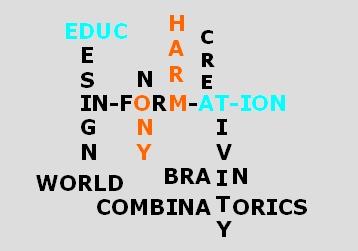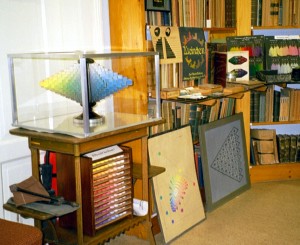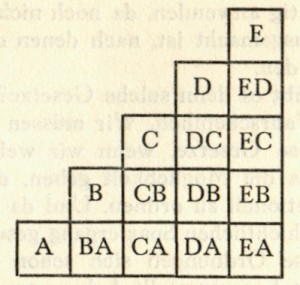Archive for May, 2008
May 13th, 2008 by thapke

Creative combinatorics is the subject of this blog as well as this blog is a way to explore this subject through creative combinatorics. So feel free to browse through using the categories or tags on the right or use the contents page which gives a short systematic overview.
May 13th, 2008 by thapke
Horst W. J. Rittel (1930 – 1990) was a German-born design theorist and university professor, educated as a theroretical physicist. He is best-known (along with M. Webber) for coining the term ‘wicked problem’, but his influence on design theory and practice was also much wider. In 1963 Rittel went to Berkeley. In 1973 he also joined the University of Stuttgart in Germany.
In his work he also thought about information systems and developed a planning/design method known as IBIS (Issue-Based Information System) for handling wicked problems. With his German colleague Werner Kunz Rittel also wrote a book on the foundation of information science in Germany (Werner Kunz and Horst Rittel, Die Informationswissenschaften: ihre Ansätze, Probleme, Methoden und ihr Ausbau in der Bundesrepublik Deutschland, München 1972).
A short biography about Horst Rittel in the publication “University of California: In Memoriam, 1992 : A publication of the Academic Senate, University of California, Information on this publication may be obtained by contacting the Academic Senate Office on any of the University of California campuses / David Krogh, Editor”
Werner Kunz and Horst W. J. Rittel, Issues as elements fo information systems. Working Paper No. 131
July 1970, reprinted May 1979, University of California, Berkeley
Chanpory Rith and Hugh Dubberly, ‘Why Horst W. J. Rittel Matters’, Design Issues 23 (2007)1, 72-91.
May 9th, 2008 by thapke
The Swiss artist and designer Max Bill founded in Germany the Ulm School for Design in the Fifties after getting his education also at the Bauhaus in the end of the Twenties. He was a theorizer about “the form” and was a proponent of a connection between mathematics as well as the physical sciences and art. Ostwald was mentioned by Bill in the afterword of the German edition of Kandinsky‘s “Point and line to planeâ€.
May 9th, 2008 by thapke
Max Bense (1910 – 1990) was a German philosopher and writer, in the fields of philosophy of science, logic, aesthetics, and semiotics. He published books about the philosophy of nature as well as “aesthetical information” and information-theory-based aesthetics. Bense worked at the University of Stuttgart since 1949 becoming full professor in 1963. In addition, he worked at the adult education centre and at the College of Design in Ulm from 1953 to 1958.
May 9th, 2008 by thapke
Root-Bernstein described the connection between art and the sciences in the view towards creativity in his abstract:
Many people view arts and sciences as being different because sciences yield objective answers to problems whereas arts produce subjective experiences I argue that art and science are on a continuum in which artists work with possible worlds whereas scientists are constrained to working in this world. But sometimes perceiving this world differently is the key to making discoveries. Thus, arts and sciences are on a continuum in which artistic thinking produces possibilities that scientists can evaluate for efficacy here and now. Not surprisingly, then, many of the most innovative scientists have had avocations in the arts, and some of the most innovative artists have had avocations in the sciences. These polymaths have often written or spoken about how their arts involvments have benefitted their scientific creativity and may provide a model for fostering a more innovative education.
Robert Root-Bernstein: The art of innovation: polymthas and universality of the creative process, in: Larisa V. Shavinia (Ed.): The International Handbook of Innovation. Oxford: Elsevier, 2003. PP. 267-278.
He argues that “artistic scientists and engineers have more image-ination, musically talented
ones duet (do it) better, and the verbally inclined have the skills to become pundits. Seriously.” (p. 270), and cited (on p. 268) Ostwald who “produced a large body of work on scientific genius that validated the polymath hypothesis”.
This supported by J. Rogers Hollingsworth who argued that:
the wider the range of experience and knowledge of the scientist, the more fields of science his/her work are likely to influence and the greater the importance with which it will be perceived. (p. 140)
J. Rogers Hollingsworth, “High Cognitive Complexity and the Making of Major Scientific Discoveries,” in Arnaud Sales and Marcel Fournier, eds., Knowledge, Communication and Creativity. (London and Thousand Oaks, California: Sage Publications, 2007). pp. 129-155.
Ostwald is mentioned here in a table of “Twentieth-century scientists who made major discoveries and were also quite active in music, art, writing, crafts and politics” (pp. 142-144)
May 9th, 2008 by thapke
Ostwald’s energetics influenced the thinking of the Russian Marxist Alexander Bogdanov (1873-1928) and his color theory the art of the Russian Avantgarde after the Revolution (e.g. Kazimir Malevich). Bogdanov himself developed also a theory of organisation which he called Tektology what he viewed as a new universal science (1922). For Bogdanov knowledge had to be seen as the organisation of experience.
Bogdanov tried, with modifications, to extent Ostwald’s project of conceiving everything in the terms of the transformation of energy. (Gare, p. 234)

- Charlotte Douglas, Energetic abstraction: Ostwald, Bogdanov, and the Russian post-revoltionary art, in: Bruce Clarke and Linda Linda Dalrymple Henderson (eds.), From energy to information : representation in science and technology, art, and literature. Stanford, Calif. : Stanford Univ. Press, 2002, pp. 76-94
- Arran Gare, Aleksandr Bogdanov’s history, sociology and philosophy of science, in: Studies In History and Philosophy of Science Part A 31 (2000) 231-248
- Charlotte Douglas, Wilhelm Ostwald und die Russische Avantgarde, in: Miltiadis Papanikolaou (Ed.), Licht und Farbe in der Russischen Avantgarde : die Sammlung Costakis aus dem Staatlichen Museum für Zeitgenössische Kunst Thessaloniki ; eine Ausstellung des Staatlichen Museums für Zeitgenössische Kunst Thessaloniki, der Berliner Festspiele und des Museums Moderner Kunst Stiftung Ludwig Wien in Zusammenarbeit mit der Griechischen Kulturstiftung Berlin. Köln: DuMont, 2004.
May 9th, 2008 by thapke
The importance to think about creativity in information and library science (1) led to considerations about how to develop information systems to support people in their creativity, e.g. in musics (2) or how the form of accessing information inluences the generation of ideas and creativity, here e.g. for managers (3).
- Petrowski, Mary Jane: Creativity research: Implications for teaching, learning and thinking, in:
Reference services review 28 (2000) 304-312
- Barry Eaglestone, Nigel Ford, Luy J. Brwon, Adrian Moore: Information systems and creativity : an emprical study, in: Journal of Documentation 63 (2007) 443-464
- Vandenbosch, B., Fay, S. and Saatçioglu, A.: “Where Ideas Come From: A Systemic View Of Inquiry,” in: Sprouts: Working Papers on Information Environments. Systems and Organizations, Volume 1 (2001) 2, 109-131.
May 9th, 2008 by thapke
Based on Auguste Comte, Ostwald developed within his philosophy of nature a “pyramid of science†in which a “science of order†(he called it also “Mathetik”) was the basis.

Ostwald ordered the sciences within a pyramid. When working on a new topic, e.g. the color theory, he combined the new topic with every layer of his pyramid in a combinatorical way to exhaust all aspect of this subject. So he developed first a basic theory of colors (e.g. EA in the picture), then viewed color theory from a physical (EB), chemical (EC), physiological or biological (ED) and psychological (E?!) view.
Ostwald planned and published a multi-vlolume work on color theory whose partial volumes in each case dealed with one of the views mentioned above. He founded a journal “Die Frabe” (The color), starting 1921, which used his monographic principle and ordered the single issues, which contain only one article, according his – as he called it – “Comte-Ostwaldian” system of concepts.
May 6th, 2008 by thapke
The colloid chemist Ernst Alfred Hauser wrote about Ostwald in 1951:
… his greatest contribution to science and education was not his discovery of how to form oxides of nitrogen by passing a mixture of air and ammonia over a platinum catalyst (a discovery for which he received the Nobel Prize for Chemistry in 1909), but rather the emphasis he always placed in his writings and lectures on the need of the young generations’ acquiring at least a basic knowledge of what he called ‘basic philosophy’ during the years it devotes to its education in colleges and universities.
Ernst Alfred Hauser, The lack of natural philosophy in our education. In memoriam of Wilhelm Ostwald, in: Journal of Chemical Education 28 (1951) 492-494.
May 2nd, 2008 by thapke
A paper which matches the topic of Ostwald’s work on the “Harmony of Forms”:
Sensual Chemistry: Aesthetics as a Motivation for Research
Abstract: Sensual, aesthetic, and even artistic considerations are an important motivation for general interest in chemistry and the development of specific research problems. Examples are given showing how these considerations have been put into play by many eminent physical, theoretical, and synthetic chemists. It is argued that more attention needs to be given to sensual and aesthetic issues in understanding how chemical discoveries are made and in order to better teach the subject.
The author Robert Root-Bernstein also wrote a short paper with the title “Wilhelm ostwald and the science of art”, in: Leornardo : Journal of the International Society for the Arts, Sciences and Technology , 39 (2006) p. 418
Robert Root-Bernstein, Sensual Chemistry – Aesthetics as a Motivation for Research, in: HYLE–International Journal for Philosophy of Chemistry, Vol. 9, No.1 (2003), pp. 33-50


